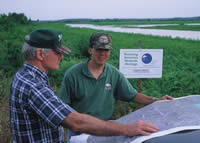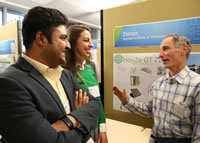Step 1 — Scope Your Problem
Start with a detailed exploration of the problem you need to solve — why it matters, what your priorities are, who’s interested and what you hope to accomplish. Explore your available approaches and pick the best one. Understand what citizen science can accomplish and what crowdsourcing can accomplish. Finally, identify the key stakeholders who will need to agree to and support solutions to the problem. Take the time to carefully frame your project and build a solid foundation so that all later steps address your needs.
The following tips will help you get started:
- Know your tools.
- Engage your stakeholders and participants.
- Know where your project fits.
- Get approval from your supervisors.
-
- mPING: Crowdsourcing Weather Reports
- Did You Feel It? Crowdsourcing Earthquake Maps
- EteRNA: Crowdsourcing New RNA Designs
- The North American Bird Phenology Program
- Cyclone Center: Crowdsourcing Hurricane Intensity Estimates
- Enhanced Passive Surveillance System: Crowdsourcing for Early Detection of Animal Disease Outbreaks
- Smithsonian Transcription Center: Crowdsourcing Document Transcription
- The GLOBE/S’COOL Parternship: Citizen Scientists Validate Satellite Data
- eBird: Crowdsourcing Bird Data
- MapGive: Crowdsourcing Map Data for Humanitarian Response and Preparedness
- Tweet Earthquake Dispatch: Crowdsourcing Earthquake Detection
- Project BudBurst: Citizen Scientists Track Seasonal Plant Changes
- The OpenPV Project: Crowdsourcing Solar Energy Data
- CoCoRaHS — Community Collaborative Rain, Hail and Snow Network: Citizen Scientists Track Precipitation
- The Air Sensor Toolbox: Citizen Scientists Measure Air Quality
Know Your Tools

Find out what specific techniques are available and which ones will best help you meet your mission goals. How might the resources available to you shape your research questions?
- Define your goals for the project: What do you want to accomplish?
- Know the strengths of your available approaches and the risks and requirements associated with using them.
- Find out what others have done with similar projects — to tell whether you’ve got a good match, verify that a new project is needed (as opposed to extending an existing project), and to strengthen your plans before you get going.
- Start thinking early about how you’ll evaluate and share results and outcomes.
-
- Buckets of Resistance: Standards and the Effectiveness of Citizen Science (2010)
- Crowdsourcing: Strength in Numbers (Journal Article, 2014)
- DIY Toolkit: Problem Definition (Video)
- Federal Ideation Programs: Challenges and Best Practices (Journal Article, 2013)
- GSA List of Third Party Sites with Amended TOS Agreements
- Guide to Choosing and Using Citizen Science (Centre for Ecology and Hydrology, PDF)
- Lessons Learned from Evaluations of Citizen Science Programs (2014, PDF)
- The NASA Solution Mechanism Guide (NASA Technical Reports Server)
- New Visions in Citizen Science (Wilson Center)
- Structuring Interdisciplinary Research Management (Journal Article, 2013)
- Transdisciplinary Research in Sustainability Science (Journal Article, 2013)
- When and How to Use Citizen Science (Centre for Ecology and Hydrology)
Engage Your Stakeholders and Participants

Find out whether stakeholders and participants are comfortable with the type of project you envision and with your ideas for how they will get involved and what technologies they will use. Talk with them to address their concerns. Don’t have just one conversation — keep talking with everyone as your plans move forward. Learn what participants want to get out of your project, what skills they have and what time and resources they can offer.
- Decide what skills you need and learn who might want to share them with you and why. If you have specific project participants or community groups in mind, learn what skills they have and what technologies they can use. Learn who else might have a stake in your project and what might get them interested in sharing resources or ideas. Understand your participants’ time commitment level and assess what training technique would be most appropriate.
- Reach out to your potential stakeholders and project participants using the media and messages that they’re comfortable with.
- Decide whether you need to “vet” volunteers to ensure that they can offer what you need. You may also need to create formal agreements before getting started (examples coming soon).
- Decide whether you need specialized vendors to provide software, sensors or other products that will help make your project a success.
- Find out what resources your users are familiar with. Are there resources you can offer as part of the project?
Know Where Your Project Fits

Once you figure out where your projects fits into the larger picture of citizen science and crowdsourcing projects, that will help you identify best practices and answer broader questions about what you’re trying to accomplish.
- Plenty of frameworks for citizen science and crowdsourcing projects are already out there. Carefully review the ones that might apply to your project — they’ll give you the big picture and ensure that you identify and answer important questions.
- Learn the basic terminology used in crowdsourcing and citizen science projects (e.g., community-based monitoring, participatory science etc.). It will help you connect with others doing similar work, make sure you don’t miss relevant resources and share your own lessons later on.
Get Approval from Your Supervisors

You’ll need to know what questions and concerns your manager and other decision makers might have about your project, and how to address them. Many resources can help you explain why crowdsourcing and citizen science projects are important and how they can help your agency meet its goals.
- Look at the resources others have used to get leadership approval and adapt them to the needs of your own project (examples coming soon).
- You’ll need to know what legal authorities you have for your project and the legal and policy requirements you may need to meet. Having these on hand can also help you collaborate more smoothly with your agency’s legal team.

